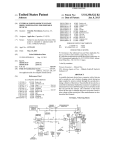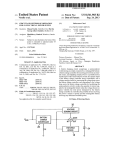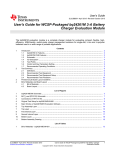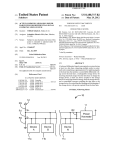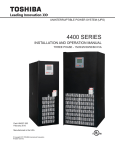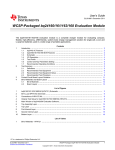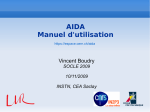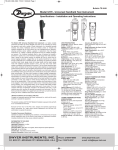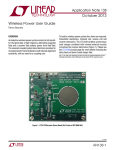Download Circuit and method of operation for an adaptive charge rate power
Transcript
US006833686B2 (12) (54) (75) United States Patent (10) Patent N0.: Veselic et al. 45 Date of Patent: US 6,833,686 B2 Dec. 21 a 2004 CIRCUIT AND METHOD OF OPERATION 6,362,610 B1 * FOR AN ADAPTIVE CHARGE RATE POWER 6,507,172 B2 * 1/2003 Sherman ................... .. 320/134 SUPPLY 6,507,173 B1 1/2003 Spiridon et 211. 6,522,118 B1 2/2003 Barcelo et a1. Inventors: Dusan F. Habicher, Veselic,Waterloo Oakville(CA); (CA);J acek Michael S. 20026136638 A1 g; Idzik, KenilWorth (CA); Jonathan T. Malton, Kitchener (CA) 3/2002 Yang ........................ .. 323/281 9/2002 ?e?“ S 6‘ al' .................... ~~~~~~~~~~~~~~~ ~~__ OTHER PUBLICATIONS (73) AssigneeZ Research In Motion Limited, Waterloo (CA) Electric Double—Layer Capacitors, vol. 2, Oct. 25, 1996 (Japan, Tokin Corp., Cat. No. EC—200E).* Supercapacitor: User’s Manual, vol. 2 (Japan, Tokin Corp., (*) Notice: Subject to any disclaimer, the term of this date uPkn0Wn)-* patent is extended or adjusted under 35 Charglng Blg Supercaps, Portable Deslgn, P~ 26, Maf U.S.C. 154(b) by 0 days. 1997* Linear Technology; LTC4056—4.2, “Linear Li—Ion Charger _ _ With Termination in ThinSOT,” Apr. 2003, pp. 1—16, USA. (21) Appl' NO" 10/372’446 (22) Filed: Feb. 21, 2003 Linear Technology; LTC4053—4.2, “USB Compatible Lith ium—Ion Battery Charger With Thermal Regulation,” 2001, (65) pp ’ * cited by examiner . 1—16 USA. Prior Publication Data US 2004/0164707 A1 Aug. 26, 2004 7 Primary Examiner—EdWard H. Tso . (51) (52) Int. Cl. ...................... .. H01M 10/44, H01M 10/46 US. Cl. ..................................................... .. 320/128 (58) Field of Search ............................... .. 320/128, 132, 320/133, 160, 164 (56) References Cited (74) Attorney) Agent) or Firm_JOneS Day; Krishna K‘ pathiyal; Charles E Meyer (57) ABSTRACT A convenient source of charging poWer for portable com munication devices is an integral poWer node of a computer U.S. PATENT DOCUMENTS data bus, such as a USB (universal serial bus) port. Unfortunately, USB ports have limited poWer capacity, 2 i ggilllizne’tlil' making them generally incompatible With battery charge 4:51O:431 A * 4/1985 Winkler controllers'(BCCs) Which are designed'to receive a steady, 5,173,855 5’229’649 5,272,475 5,444,378 5,631,503 5,638,540 5,651,057 Nielsen et aL Nielsen et a1_ Eaton et a1. Rogers Ciof? Aldous Blood et a1‘ high capacity input. The invention provides a battery charg ing circuit Which adjusts to the parameters of an external power supply such as a USB port by adding a regulating circuit to a standard BCC design. This regulating circuit maximiZes the current draWn by the BCC, While keeping the voltage to the BCC above a preset minimum (the loW voltage shut off level for the BCC). If the voltage to the BCC gilreras Sr‘ begins to drop, the regulating circuit reduces the current A A A A A A A * * * * * * * 2 * 12/1992 7/1993 12/1993 8/1995 5/ 1997 6/1997 7/1997 518501113 A * 12/1998 Weimer ’et a1‘ draWn, so the voltage rises and stays Within the operating 5,939,860 A * 6,104,162 A * 8/1999 William 8/2000 Sainsbury et 211. range Ofthe BCC 6,104,759 A * 8/2000 Carkner et a1. 16 Claims, 4 Drawing Sheets SUPPLY. ANDTO REMNBEABLEBATTEKV nsrmmmwwvm'raee *2 OFLEVELWRBATTERY 8 owns: AIME LONVGJABESHUTCFF LEVE U.S. Patent Dec. 21, 2004 Sheet 1 0f 4 US 6,833,686 B2 “" PORTABLE PC DEVICE 12 USB J Vans FIGURE 2 Raw U.S. Patent Dec. 21,2004 Sheet 2 0f4 K16 RGABLE a VBUS US 6,833,686 B2 K30 VCHRG . BATI‘CHARGE as _________________ __ \_ CON'IRQLLER ‘~38 v *5 a4 \__.. CURRENT REGULATOR FIGURE 3 f '6 V 52 RCABLE M W\. / "cm W» an‘ LTCl1'34 BA'ITCHARGE CONTROLLER I SENSE '- _ U.S. Patent Dec. 21, 2004 Sheet 3 0f 4 US 6,833,686 B2 [16 Vuss 52 ‘Rm’. VCHRG E: ,c / FAST CH - FIGURE 5 U.S. Patent Dec. 21, 2004 Sheet 4 0f 4 US 6,833,686 B2 FIGURE 7 ‘couuecnme mneavcrmss comaouzn woacrmmmwsa 9° J’ SUPPLY. AND TO REG-MRGEABLE BATTERY l DETERMINING LOW VOLTAGE 92 Sl-IUTOFF LEVELFOR BATTERY -' CHARGE cowmousn L MoNnoRmc VOLTAGE PROVIDED )4 TO BA‘I‘I'ERY Cl-IARGE OONTROLLER i MAXIMIZING CURRENT movnoen avamsnv CHARGE CONTROLLER. WHILE KEPING VOLTAGE T0 BATTER CHARGE CONTROLLER ABOVE LOWVOLTAGE SHUTOFF LEVEL 9s -/ US 6,833,686 B2 1 2 CIRCUIT AND METHOD OF OPERATION FOR AN ADAPTIVE CHARGE RATE POWER SUPPLY USB ports Would seem to be a very logical choice as a poWer supply for portable devices for a number of reasons. To begin With, USB ports supply a loW DC voltage supply Which is often very close to, or just above, the voltage of the This invention relates in general to battery chargers, and battery being charged (many portable devices having battery more speci?cally to a method and apparatus for charging a battery in a portable communication device from a variety of voltages in the range of 2.5—4.5 VDC). As Well, many portable devices may be operable to upload and doWnload poWer sources, including limited capacity sources such as an data or softWare, to and from a personal computer or a laptop integral poWer node of a computer data bus. One such computer data bus Would be a USB (universal serial bus) port. computer (often referred to as “syncing”). Thus, many 10 Ward system, as the docking cradle 10 is connected to a USB BACKGROUND OF THE INVENTION port 12 of a personal computer (PC) 14, via a simple USB cable and connectors 16. The mobile device 18 need only be With the current computing and information revolution, portable electronic devices such as cellular telephones, per placed into the docking cradle 10 and an electronic connec tion to the (PC) 14, is made. sonal digital assistants (PDAs), digital pagers and Wireless If the USB port 12 has suf?cient poWer, it makes much email devices, are becoming very common. more sense to use the USB port 12 to supply charging poWer These portable devices are typically poWered by internal to the mobile device 18, rather than using a separate AC batteries Which must be recharged periodically by an exter charger. For example: nal poWer source, using a battery charger. Battery chargers a USB poWer supply Will have less electrical noise than an generally receive poWer from a standard AC electrical outlet and convert the AC poWer into a loW DC voltage for recharging a battery. The battery chargers of these portable devices also gen erally employ a “battery charge controller” to manage the charging of the battery. Such battery charge controllers offer AC charger, unless the AC charger incorporates large DC capacitors or inductors; an AC charger requires either a heavy transformer or an expensive sWitching poWer supply current, neither of 25 functionality such as: able battery; providing status signals to the main processor of the portable device, or operating one or more status LEDs (light emitting diodes); providing protection circuits such as overcurrent, undervoltage, and overtemperature protection; and 35 demands. This is a problem When one attempts to use a 40 poWer supply With limited capacity or When the poWer is delivered via unknoWn length and gauge of poWer Wires (the resistance of such poWer Wires cause a voltage drop Which aggravates the problem). Some computer data buses such as USB (universal serial bus) buses can be used to provide poWer to external devices, but While such poWer supplies are very convenient, they have limited capacity and are deliv ered via standard USB cables Whose poWer Wires could vary provided as a separate physical component, and a given AC power supply may require 120 VAC or 240 VAC as an input, and may provide 3, 4.5, 6, 7.5 or 9 VDC out, With one of large number of different pos sible connectors and polarities. A traveller Who forgets an AC poWer supply at home, may not be able to ?nd a replacement. In contrast, the USB standard is Widely accepted, so that a traveller Whose mobile device is equipped With a USB connector Will have a much greater chance of ?nding a charging source. Unfortunately, USB ports can only provide limited poWer, While typical battery charge controllers are designed to receive a steady, high capacity poWer supply (that is, the 45 input voltage at the battery charge controller is at or near its designed value, and does not drop as charging current increases.) The problem becomes clear When considering the block diagram of FIG. 2. The components of FIG. 2 are the same as those of FIG. 1, speci?cally, a docking cradle 10 poWered from a USB port 12 of a PC 14, via cable and in length and gauge (anyWhere from 20 AWG—28 AWG, for example). The majority of personal computers (PCs) and laptop connectors 16, and feeding a portable device 18 resting in the cradle 10. From this presentation, it is clear that the computers available today, are provided With one or more voltage output from the USB port 12, VUSB, Will drop as it USB ports as standard components. USB ports are designed to support data communication at speeds of 12 megabits and 1.5 megabits per second (USB 2.0 provides for up to 480 Which Would be required if USB poWer is used; in the USB poWer supply implementation, the cable and connectors 16 used to connect the docking cradle 10 to the PC 14 could be used to carry both poWer and data, so no extra physical components Would be required at all. In contrast, an AC poWer supply Would have to be regulating the voltage and current levels to the recharge shutting themselves off When the charging source has been removed, to minimiZe battery drain. Unfortunately, most of these battery charge controllers are designed to draW from a high capacity poWer supply With a steady voltage that Will not sag appreciably under its current portable devices are supplied With docking cradles as shoWn in the system diagram of FIG. 1. This is quite a straightfor 55 megabits per second), support PnP (Plug and Play) instal crosses the cable and connectors 16, due to its resistance, RCABLE. If either the cable resistance (RCABLE) or the current lation softWare, and support hot plugging (i.e. devices can be connected and disconnected While the PC is running). Thus, draWn (ICABLE) is too great, the voltage arriving at the battery charge controller in the mobile device 18, may be too loW. This loW voltage Will cause many standard battery USB ports are often used as interfaces to connect keyboards, mouses, game controllers, printers and scanners to PCs. As Well, USB ports are able to supply limited poWer to a to charge the battery in the portable device 18 ef?ciently. True, neW dedicated battery charge controllers could be connected device. The standard USB speci?cation requires that “high-power” USB ports be operable to provide a supply voltage of 4.75—5.25 VDC and supply a maximum current of at least 500 mA (?ve units). The speci?cation for charge controllers to either shut doWn or to oscillate and fail developed Which are operable With the limited USB poWer supply and resistance of the cable and connector system, but that Would be an expensive and complicated solution. Such 65 a design Would become even more complicated to be “loW-poWer”USB ports requires a supply voltage of compatible With both computer data bus poWer supplies and 4.40—5 .25 VDC and current of 100 mA (one unit). other poWer sources, such as AC poWer supplies. US 6,833,686 B2 4 3 steady, high capacity poWer supply While such a poWer supply is often unavailable, or is simply inconvenient. One of the most common battery charge controllers, for example, the LTC1734 from Linear Technology Corporation is There is therefore a need for a method and apparatus Which allows standard battery charge controllers to be supplied With poWer from standard computer data busses such as USB ports. This design must be provided With designed to receive 5 VDC in, and has a loW voltage lockout at 4.53V (that is, if the LTC1734 receives a supply voltage consideration for the cost of electrical components, the limited physical board area in portable devices, the reliabil ity and the complexity of the design. It is also desirable that this method and apparatus be operable With both computer of less than 4.53 VDC, it simply shuts doWn.) When the voltage drop across the supply cable and connectors 16 are data bus poWer supplies, and other poWer sources such as considered, the voltage supplied by the poWer node of a data AC poWer supplies. bus such as a USB port, may be loWer than this loW voltage 10 SUMMARY OF THE INVENTION inexpensive and reliable, it cannot be used effectively in this It is therefore an object of the invention to provide a novel method and apparatus Which alloWs standard battery charge controllers to be supplied from standard computer data ports and other poWer sources, Which obviates or mitigates at least lockout. Therefore, though the LTC1734 is Widely available, 15 environment. A circuit Which overcomes this problem, is presented as a block diagram in FIG. 3. This ?gure presents a battery charging circuit Which uses a standard battery charge con troller 30 knoWn in the art, coupled to a rechargeable battery one of the disadvantages of the prior art. One aspect of the invention is broadly de?ned as a battery charging circuit Which adjusts to the parameters of an With poWer from some manner of external poWer, such as a external poWer supply, to minimize charge time, comprising: computer data bus. This poWer connection is presented in a battery charge controller connected to the external poWer supply and electrifying a battery; and a regulating circuit for Will be reduced due to the resistance of the electrical cable maximiZing the current draWn by the battery charge controller, While keeping the voltage to the battery charge and connectors 16, RCABLE. Thus, the battery charge con troller 30 only receives a voltage of VCHRG=VBUS— controller above a preset minimum limit, the preset mini mum limit corresponding to a loW voltage shut off level for or batteries 32. The battery charge controller 30 is provided FIG. 3 in the form of input voltage VBUS. This VBUS voltage 25 (RCABLEXICABLE) - As Will be explained in greater detail hereinafter, the voltage drop across RCABLE may result in the VCHRG voltage being loWer than the loW voltage threshold for the battery the battery charge controller. Another aspect of the invention is broadly de?ned as a method for charging a battery of a portable device via an charge controller 30. The invention therefore adds a current external poWer supply, Which adjusts to the parameters of the external poWer supply to minimiZe charge time, the regulator 34 to the circuit. The resistance RCABLE is of course ?xed, but by reducing the current draWn by the method comprising the steps of: connecting a battery charge battery charge controller 30, ICABLE, the voltage drop across controller to the external poWer supply and to a rechargeable RCABLE Will decrease, thus avoiding the loW voltage shut off of the battery charge controller 30, and alloWing the battery battery in the portable device; determining a loW voltage shut off level for the battery charge controller; monitoring the voltage that the external poWer supply provides to the battery charge controller; and maximiZing the current draWn by the battery charge controller, While keeping the voltage to the battery charge controller above the loW voltage shut off level for the battery charge controller. 35 Supply (ICABLE)> While 40 keeping the VCHRG voltage greater than the loW voltage BRIEF DESCRIPTION OF THE DRAWINGS These and other features of the invention Will become more apparent from the folloWing description in Which reference is made to the appended draWings in Which: FIG. 1 presents a physical layout of a personal computer 32 to be charged. A number of current regulators 34 are described herein, but in general it desirable that the current regulator: maximiZe the current being fed to the battery 32, and therefore maximiZing the current draWn from the poWer shut off level of the battery charge controller 30. In some embodiments of the invention the current regu lator 34 uses VCHRG as an input (via connection 36), While 45 in other embodiments the current regulator 34 uses an output of the battery charge controller 30 (via connector 38). Still connected to a portable electronic device in a manner knoWn other embodiments use no feedback to the current regulator in the art; FIG. 2 presents a block diagram of the system presented 34. Say, for example, that the voltage provided from the computer data bus is 4.75—5.25 VDC; that is, VBUS= in FIG. 1, highlighting the problem of voltage drop betWeen the personal computer and the portable electronic device; FIG. 3 presents a electrical schematic diagram of a battery charging circuit in a broad embodiment of the invention; FIG. 4 presents an electrical schematic diagram of a battery charging circuit using a comparator, in an embodi ment of the invention; FIG. 5 presents an electrical schematic diagram of a 55 4.75—5.25 VDC; the circuit must therefore be designed to operate at VBUS=4.75 VDC. Suppose also that the resistance of the cable and connectors 16 is 0.5 ohms (RCABLE=0.5 ohms) and that the loW voltage shut off of the battery charge controller 30 is 4.53 VDC. The battery charge controller Will endeavour to draW as much current as needed to charge the battery 32, Which, in the case of a USB bus, Will be limited battery charging circuit using an electronic potentiometer, in to about 0.5 A. Thus, the voltage arriving at the battery an embodiment of the invention; charge controller, VCHRG, Will be: FIG. 6 presents a timing diagram of charging current provided by the embodiment of FIG. 5; and VCHRG = VBUS — RCABLE X 1 CABLE FIG. 7 presents a How diagram of an example method for charging a battery in a mobile device. (1) = 4.75 VDC - (0.5 ohmsXO.5 A) = 4.5 VDC DESCRIPTION OF THE INVENTION The general problem addressed by the invention is that typical battery charge controllers are designed to received a 65 If the loW voltage shutdoWn of the battery charge con troller is higher than VCHRG=4.5 VDC, it Will therefore US 6,833,686 B2 5 6 shutdown. This is the case for the LTC1734 controller, for example, Which shuts doWn at 4.53 VDC. In the constant voltage mode (entered When the charge voltage of the battery 32 reaches 4.2 VDC externally), the The above calculations did not even take into account LTC1734 controller 52 servos its DRIVE pin to maintain its component tolerances, Which cannot be ignored. The BAT pin at 4.2 VDC. In this mode, the current provided by the LTC1734 controller 52 Will necessarily drop, and the current ?oWing out of the PROG pin Will drop accordingly. As this latter mode of operation is not affected by the system LTC1734 application notes state that this device has a tolerance of 1%. If the current regulator 34 incorporates a number of simple components then the circuit of FIG. 3 may easily have a tolerance of 3% or so. described herein, it Will not be discussed in any further detail. Thus, VCHRG may effectively be in the range of 4.37 VDC; Well beloW the 4.53 VDC cut off for the LTC1734 10 battery charge controller. Equation (1) can also be used to determine a current level, ICABLE, Which does not cause the battery charge controller USB equipment under a high load (i.e. 500 mA), VCHRG 30 to shutdoWn: 15 VCHRG = VBUS — R CABLE >< [CABLE (1) [CABLE = (VBL/s — VcHRc)/ R CABLE (2) 20 [CABLE = (VBL/s — VCHRG >< 3%)/RCABLE input of the comparator 50 and compares it to a reference voltage (VP) Which is fed to the comparator 50’s non inverting input. VP is derived by loW-pass ?ltering the LTC1734 control ler 52’s PROG pin output through resistor R5 and capacitor Thus, reducing the current ICABLE to 0.44 A is sufficient to avoid the loW voltage shut off of the battery charge control ler 30. AlloWing for 3% tolerance: may be pulled as loW as 4.35V—too loW for the LTC1734 controller 52 to operate. To prevent this, the comparator 50 monitors VCHRG (scaled doWn to a more useful voltage— VN—by the voltage divider R1 and R2) fed to the inverting = (4.75 - 4.53)/0.5 : 0.44 A As noted above, the minimum required voltage at VCC for proper operation of the LTC1734 controller 52 is 4.53 VDC, and the USB speci?cation states that for standard C2, as VPROG=15 VDC When the LTC1734 controller 52 is 25 operating in the constant-current mode. R5 also serves to isolate other components from the LTC1734 controller 52, ensuring proper operation of the LTC1734 controller 52. (Z) Resistors R1 and R2 are chosen such that VCHRG is a = (4.75 - 4.53 X 1.03)/0.5 suitable tolerance above 4.53 VDC When VN=1.5 VDC. = (0.09)/0.5 30 In the intended and published usage of the LTC1734 controller 52, the voltage across resistor R3 is simply VPROG That is, the current ICABLE may have to be reduced to 0.18 A to avoid the loW voltage shutdoWn. Thus, the use of the circuit in FIG. 3 alloWs computer data buses and similar poWer supplies With limited capacity, to be since R3 is intended to be tied betWeen PROG and ground. In such a con?guration, determining and setting a ?xed 35 as most alternative ideas suggest, this circuit adjusts the voltage across a ?xed R3 by changing the voltage across C1 used to charge mobile devices, Without causing the battery charge controller 30 to shut doWn. The solution of this embodiment adapts to the capabilities of any external poWer source to minimiZe charge time. If, for charge current ICHRG, is straightforWard. In the system of the invention, rather than adjusting R3 to control charge current (that is, Vcl) such that: 40 ICHG = 1.5v-vC, example, 5 VDC arrives at the input of the battery charge controller 30 With unlimited current and no voltage drop as the current draW increases, then the regulating circuit 34 Will VC1 is controlled by the comparator 50. As the comparator not restrict the current draWn. 45 50 is an open-drain comparator (a MAX9120 comparator A number of different embodiments Will noW be Was used for testing purposes, though similar parts such as described. Each embodiment uses a very small number of the LMV7235 should Work as Well), When VN>VP, the simple, reliable components. Thus, as a Whole, the invention provides an effective solution Which is inexpensive, reliable and consumes minimal board space in a portable device. comparator 50 Will sink current into its output pin; otherWise the output pin Will ?oat. 50 The control loop operates as folloWs: 1. as ICHRG drops, the voltage drop across the cable and Comparator Embodiment FIG. 4 presents an electrical schematic diagram charging circuit Which employs tWo main components: a comparator 50 and a LTC1734 battery charge controller 52 having a current control pin PROG. Varying the current draWn through the control pin PROG Will vary the current supplied 55 VHYS (VHYS being the input hysteresis for the comparator 50), the comparator 50 Will turn on its output and pull charge out of C1, decreasing VC1 and causing ICHRG to by the LTC1734 battery charge controller 52 to the battery 32. DraWing more current out of the PROG pin Will increase increase; 60 the charge current, While reducing the PROG current Will reduce the charge current. Many battery charge controllers have a similar current control system, but this embodiment Will be described With respect to the LTC1734 controller. The LTC1734 controller can be operated in either constant current mode, or constant voltage mode. connectors 16 also drops, so VCHRG rises, per equation (1) above. As VCHRG rises, the positive input to the compara tor 50, VN, Will also rise. For VN rising, When VN>VP+0.5 2. as ICHRG increases, the voltage drop across the cable and connectors 16 rises, causing VCHRG, and consequently VN, to drop. For VN falling, When VN<VP—0.5 VHYS, the 65 comparator 50 turns off its output, alloWing the LTC1734 controller 52’s PROG pin to pour charge into C1, causing VC1 to increase and decreasing ICHRG. Resistor R4 smooths out the ripples on C1 and limits current transients through the comparator 50’s output. US 6,833,686 B2 8 7 When the power supply is capable of supplying all the of current supply, but uses a reset circuit to stop the ramping before the loW voltage threshold is exceeded. poWer the LTC1734 controller 52 can handle, VC1 Will be at a minimum and ICHG Will be approximately determined by: Like the embodiment of FIG. 4, this circuit uses the LTC1734 battery charge controller 52, though other battery ICHG = charge controllers having a current control pin PROG could also be used. HoWever, rather than having a comparator (4) circuit as in FIG. 4 Which modulates the current draW to ROUT is the resistance from the comparator 50’s output to GND When the output is active. Because the LTC1734 controller 52 is susceptible to malfunction due to capacitive effects in the PROG circuit, it is best to keep R4§0.1R3, but this Will depend on the application, and can easily be avoid the loW voltage shut off, this circuit ramps from a loW current level, through to a high current level. Before the loW 10 includes provisions for setting the current draW to a number determined by one skilled in the art. When poWer is ?rst applied to this circuit through VBUS, VC1=0 and the charger Will start and stay on. Ahigh-on-reset 15 of predetermined and ?xed levels. Looking ?rst at the simplest case, With the inputs FAST CH, HI/LO CH and ADJUST all at 0 VDC, then there Will be no current ?oW through either of the semiconductors Q2 or Q3. The resistance betWeen PROG and ground Will therefore be equal to the sum of resistors R6 and R7, and this Will determine the current ?oW through the LTC1734 con signal of 3.0V applied to CHGiCTRL Will keep the charger off; once the “off” state has been established, the CHGi CTRL signal can be removed. Conversely, pulling CHGi CTRL to GND for a period of time and then ?oating it Will troller 52. If these resistors are set to 2.2 kohms and 12.8 turn on the charger. Testing of Comparator Embodiment The circuit of FIG. 4 Was tested With the folloWing component values: voltage threshold is reached, the LTC1734 controller 52 shuts doWn and the cycle is repeated. The circuit also 25 R1=10.0 kQ kohms respectively, then the circuit Will provide 100 mA. If the FAST CH is held high, then current Will ?oW through R6, and the resistance from PROG to ground Will only be 2.2 kohms. Thus, the current ?oW through the LTC1734 controller 52 Will be approximately 750 mA. This setting Would not be useful With a loW capacity supply such as a USB port, but could be used With a high capacity supply such as an AC transformer. Finally, With the HI/LO CH input high, current Will ?oW through resistor R8, electronic potentiometer R9, and Q2. R5=10.0 kQ Resistor R8 preferably has a value of 1 kohm, and R9 is preferably a MAX5467 potentiometer, Which has a range of 0—10 kohms, in 32 discrete steps. Thus, this circuit Will step The R4, C1 time constant Was chosen to be at least 10 times larger than the propagation delay of the MAX9120 for 35 stability. through a resistance of 11 kohms doWn to 1 kohm in 32 discrete steps (note that this circuit is in parallel to R7, so R7 must be considered in determined the current draWn from For testing purposes, a 19 resistor Was used to simulate PROG). This Would result in the current output similar to that shoWn in FIG. 6 (the number of steps that Would the resistance of the supply cable and connectors 16. With VBUS=6 VDC, ICHRG=440 mA. As VBUS Was gradually reduced, ICHRG remained at 440 mA until VBUS=5 .075 VDC, at Which point ICHRG started to 40 drop. By the time VBUS=4.71 VDC, the charge current ICHRG, had dropped to 92 mA. Using an HP54645D oscilloscope to probe the LTC1734 controller 52’s VCC pin shoWed the folloWing; for ICHRG=440 mA and VBUS=5.075 VDC, VCC=4.63 VDC; and for ICHRG=92 mA and VBUS=4.71 VDC, VCC=4.63 VDC. This is consistent With the chosen values of R1 and R2, using the PROG reference scheme. With VBUS=4.63 VDC the LTC1734 controller 52 turned off and VPROG=4.625 VDC. By returning VBUS to 6 VDC, the LTC1734 controller 52 could be turned on again by momentarily pulling CHGi CTRL to GND. Similarly, pulling CHGiCTRL above about 45 using a microcontroller or similar device. As Well, hardWare components such as an oscillator could also be used to control the rate through Which the steps of potentiometer are stepped. In the preferred embodiment of the invention, the HI/LO CH input also feeds the CS pin on the MAX5467. This is a “chip select” input—in combination With U/D input fed by the ADJUST input, it is used to increment or decrement the electronic potentiometer R9. Also, a separate reset circuit is provided using resistors R10, R11, R12, capacitor C3, and 55 2.25 VDC turned the LTC1734 controller 52 back off. transistor Q3. This circuit could be poWered using any reliable voltage V2 (in the preferred embodiment. V2=+3.3 VDC, Which is provided from VUSB and a voltage regulator). The preferred values for the components in this circuit are: Digital Potentiometer Embodiment The invention is not strictly limited to the case Where the loW voltage threshold is never exceeded. In the embodiment of FIGS. 5 and 6, for example, the loW voltage threshold could be exceeded With each periodic cycle of current ramping, but the duty cycle still be suf?cient to charge the battery. The only dif?culty With such a circuit is that it Would be necessary to reset the battery charge controller With each cycle. The circuit of FIGS. 5 and 6 ramps through a range actually be made prior to reaching the loW voltage shut off varies With the particular application due to component values and tolerances, and other factors). The ADJUST and HI/LO CH inputs could be controlled 65 R6=2.2 kohms R7=12.8 kohms R8=1.0 kohms R9=10 kohms R10=200.0 kohms R11=10.0 kohms R12=200 kohms US 6,833,686 B2 9 10 Software Embodiments Rather than using only electronic hardWare as shown modi?cations may be made to such embodiments Without departing from the true scope and spirit of the invention. For example: above, the invention may also be implemented using a 1. the circuit of the invention could be used With any combination a hardWare and softWare components, includ ing programmable devices such as digital signal processors manner of poWer source including: conventional AC (DSPs), microcontrollers, ?eld programmable gate arrays poWer supplies (often referred to as “bricks”), com puter data busses such as USB ports, external battery (FPGAs), application speci?c integrated circuits (ASICs) and the like. Such an embodiment could be implemented as shoWn in the How chart of FIG. 7. Like the embodiments described above, this method could be used to charge any rechargeable battery in a portable or similar electronic device. Any external poWer supply could be used, though the invention is most useful With poWer supplies of limited capacity. The method of the invention adjusts to the parameters of external poWer supplies to minimiZe charge time. As shoWn in FIG. 7, the method of the invention begins at step 90 by connecting a battery charge controller 30 to the external poWer supply and to the rechargeable battery in the portable device 18. As described herein above, the connec packs, laptop poWer supplies, DC outlets on aircraft; 2. any manner of electrical appliance could be charged 10 personal digital assistants (PDAs), cellular telephones, Wireless email and paging devices; and 3. any manner of rechargeable battery could be used including single or multiple lithium-ion, nickel 15 eters of an external poWer supply, to minimiZe charge time, comprising: portable device 18. A loW voltage shut off level for the battery charge a battery charge controller connected to said external controller in the portable device 18 is then determined at step 25 age to said battery charge controller above a preset minimum limit, said preset minimum limit correspond grammed into it. The voltage provided by the external poWer supply to the battery charge controller 30 is then monitored at step 94. This step could be provided periodically, continuously, or in ing to a loW voltage shut off level for said battery charge controller. 2. The battery charging circuit of claim 1 Where said battery charge controller to includes a current control input. 3. The battery charging circuit of claim 2 Where said response to an event, such as a change in the charge current. Various devices, such as microcontrollers, are often pro regulating circuit comprises: vided With integral ADCs (analogue to digital converters) Which could be used to perform this monitoring function. The current draWn by the battery charge controller 30 is then maximiZed at step 96, With the limitation that the voltage being supplied to the battery charge controller 30 40 a comparator for receiving a voltage signal from the input to said battery charge controller and a reference voltage microcontrollers have DAC (digital to analogue converter) 45 signal, and responds to said voltage signal being less than said reference voltage by reducing the current supplied by said battery charge controller. 5. The battery charging circuit of claim 3 Where said regulating circuit comprises: an electronic potentiometer operable to incrementally decrease its resistance in response to control pulses from a microprocessor, thereby incrementally increas ing the current supplied by said battery charge control ler. the art. 6. The battery charging circuit of claim 3 Wherein said Even the hardWare embodiments of the invention could be encoded in a softWare form such as the hardWare develop regulating circuit comprises: an electronic potentiometer operable to cyclically ramp ment languages (HDL code) used to fabricate integrated though its range of resistance, thereby cycling the current supplied by said battery charge controller circuits. This HDL or similar code could be stored on any electronic memory means such computer diskettes, through a range of 0 Ato a current level that causes said CD-Roms, Random Access Memory (RAM) and Read Only battery charge controller loW voltage shut off to trip. 7. The battery charging circuit of claim 4 Wherein: said reference voltage is provided by said battery charge Memory (ROM). As Well, electronic signals representing this softWare code may also be transmitted via a communi cation netWork. Options and Alternatives While particular embodiments of the present invention have been shoWn and described, it is clear that changes and a regulating circuit responsive to the voltage at the input to said battery charge controller by adjusting the cur rent draWn by said battery charge controller to keep the voltage at the input to said battery charge controller above said preset minimum limit. 4. The battery charging circuit of claim 3 Where said regulating circuit comprises: controlled in a number of manners. For example, most outputs Which could be used to control the current provided by a device such as the LTC1734 controller 52, described herein above. The balance of the softWare code needed to perform this algorithm Would be straightforWard to one skilled in the art. The method steps of the invention may be embodiment in sets of executable machine code stored in a variety of formats such as object code or source code, integrated With the code of other programs, implemented as subroutines, by external program calls or by other techniques as knoWn in poWer supply and electrifying a battery; and a regulating circuit for maximiZing the current draWn by said battery charge controller, While keeping the volt ler 30 being used in the portable device 18 can be pro must be kept above the loW voltage shut off level. The current draWn by the battery charge controller 30 could be cadmium, or other types of cells. Again, such implementations Would be clear to one skilled in the art from the teachings herein, and do not take aWay from the invention. What is claimed is: 1. Abattery charging circuit Which adjusts to the param tion to the external poWer supply is preferably made via a USB cable and connectors 16, and a cradle 10 to hold the 92. This loW voltage shut off level is generally predeter mined as the softWare algorithm is executed by the portable device 18, and the parameters of the battery charge control With such a circuit including portable laptop computers, controller. 65 8. The battery charging circuit of claim 4 Wherein: said comparator circuit further comprises a voltage divider for scaling doWn said voltage signal from said US 6,833,686 B2 11 12 When the voltage of the supply drops beloW a preset reference, to avoid said preset limit. power mode, and said reference voltage signal is scaled doWn proportionally. 9. The battery charging circuit of claim 4 Wherein: said regulating circuit further comprises a capacitor cou pling the output of said comparator to ground, thereby smoothing out variances in the output of said compara 15. A battery charger comprising: tor. 10. The battery charging circuit of claim 4 Where said external poWer supply comprises a computer data bus hav ing a poWer node. 11. The battery charging circuit of claim 10 Wherein: said computer data bus is a Universal Serial Bus (USB). 12. The battery charger of claim 4, Wherein said com parator circuit has a hysteresis, Whereby said battery charge controller Will not begin to deliver current again until said voltage level of said computer data bus is Well above said 10 15 portable device; determining a loW voltage shut off level for said battery reference voltage. charge controller; 13. The battery charger of claim 4, Wherein said com parator is operable to loWer the charge current When the voltage of the external poWer supply drops beloW a preset reference level. monitoring the voltage that said external poWer supply provides to said battery charge controller; and maximiZing the current draWn by said battery charge controller, While keeping the voltage to said battery charge controller above said loW voltage shut off level for said battery charge controller. 14. The battery charger of claim 4, Wherein said battery charge controller includes a loW voltage shut off circuit, said battery charge controller shuts off if the incoming voltage falls beloW a preset limit, and Wherein said regulating circuit loWers the current output of said battery charge controller a battery charge controller Whose current output varies With the voltage applied to a control signal input; and a comparator for loWering the charge current When the voltage of the supply drops beloW a preset reference level. 16. A method for charging a battery of a portable device via an external poWer supply, Which adjusts to the param eters of said external poWer supply to minimize charge time, said method comprising the steps of: connecting a battery charge controller to said external poWer supply and to a rechargeable battery in said 25 * * * * * UNITED STATES PATENT AND TRADEMARK OFFICE CERTIFICATE OF CORRECTION PATENT NO. : 6,833,686 B2 Page 1 of 1 APPLICATION NO. : 10/372446 DATED INVENTOR(S) : December 21, 2004 : Dusan Veselic et a1. It is certified that error appears in the above-identi?ed patent and that said Letters Patent is hereby corrected as shown below: Cover Page, Col. 2, Under (74) Attorney, Agent or Firm, remove “Charles B. Meyer” Signed and Sealed this Thirty-?rst Day of October, 2006 m Wan,” JON W. DUDAS Director ofthe United States Patent and Trademark O?ice













